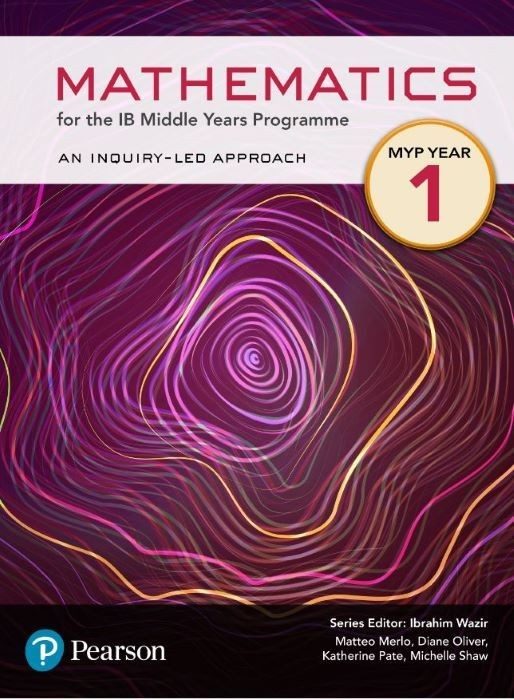
Paula Rowlands has taught International GCSE, A Level, MYP and DP Mathematics since 2007 and is currently the Head of Mathematics at an MYP and DP School in Switzerland. She is a co-author for Pearson’s new Mathematics for the IB Middle Years Programme series and shares in this article her observations on how teachers can support a successful transition from MYP to DP Mathematics.
The transition from MYP to DP should be seamless and smooth. The two programmes are designed by the IB to dovetail together as a part of the IB continuum. The MYP is a framework that develops the skills students need, and the DP continues to develop the application of these skills within an academically rigorous environment. But here’s the question: why do some students, teachers, and parents believe there is a disconnect between the two programmes for mathematics (Hallinger, Tampubolon)?
In the first article in this new blog series, I will reflect on some observations and strategies that can be used to make the MYP to DP transition as smooth as possible and highlight how Pearson’s new series of MYP mathematics resources can be used to support the transition. In the blog posts that follow, I will expand on these strategies and demonstrate how the series can support teachers with developing the written curriculum, delivering the taught curriculum, and assessing the objectives.
The mathematics progression map
Students’ progress through mathematics is a journey: slow in places and fast in others, and as with every journey, being as prepared as possible for what lies ahead is always advisable. Planning the route to your destination with a detailed map and making sure you are ready to set off with everything you need is key. A mathematics journey is no different; we need a progression map, and we need to start each new section with as many key skills in place as possible.
Content progression
Content knowledge is important, understanding in mathematics is a sequential process and introducing students to a topic area without them acquiring the conceptual understandings that underpin it will hinder their progress. For students, gaps in their prior knowledge leaves them feeling unprepared. Although it is difficult to ensure all students have the necessary embedded understanding, having a clear curriculum document available that outlines the progression of topics will help to structure the preparation, and help students feel they are more ‘content ready’.
For some schools, this can take the form of a structured, published and externally assessed curriculum, such as the International GCSEs. However, for schools following the MYP, there is a requirement to develop their own written curriculum: ‘IB World Schools are responsible for developing and structuring MYP mathematics courses that provide opportunities for students to meet the aims and objectives of the programme’ (IB MYP). Although this can allow a great deal of flexibility, it can also lead to a disconnect between the MYP and DP programmes, and hence a rocky transition, if it is not completed carefully, with attention to detail and pedagogical considerations. It is also a daunting task for those trained in pedagogy rather than curriculum design, which may explain the feeling of an MYP/DP disconnect for some teachers.
In recognition of this, the new Pearson Mathematics for the Middle Years Programme series includes Teacher Guides that contain a detailed mapping of the textbook content to the requirements of each of the four 2019 DP courses. The progression of topics through the books is in line with the MYP 2020 guidelines and the mapping document demonstrates how the skills developed within each chapter underpin the skills that will be further developed within the four DP courses and in line with the Learning Standards at the heart of the IB philosophy (IB. Standard: Designing a coherent curriculum (0401), practices 1, 2 and 3, page 14). The Teacher Guides also contain adaptable unit plans that can help individual schools plan the content component of their MYP courses.
The unit plans are not designed as rigid MYP units, but rather as indicators of how a topic area can be presented. This allows teachers to adapt the use of the series for their school’s particular circumstances, therefore helping to provide content progression structure and support for the transition in terms of sequential content knowledge acquisition. This will be explored in more detail in my next blog post: Supporting a successful transition from MYP to DP mathematics – written curriculum.
Skills progression
Although an essential part of the written curriculum, a smooth content progression is not enough on its own. Students starting any of the DP mathematics courses will be at a distinct advantage if they have developed the following vital skills:
- Being curious, inquisitive, and confident to explore new mathematics concepts.
- A conceptual understanding of the content rather than procedural skills.
- A clear understanding of the command terms, notation and formulae used in the IB programme.
- An appreciation of mathematics as an interconnected subject.
- An awareness of the 12 key concepts that are within the MYP and DP mathematics programmes.
- A set of strategies they can rely upon to approach problems rather than steps they remember in order to get to the answer.
These observations are supported by comparing the aims of the MYP with the DP. The aims of the two programmes are clearly aligned, and the progression from MYP to DP is visible (Subject Guides: MYP page 7, DP page 20). If the aims of the MYP programme are met, the transition for schools to meet the aims of the DP course should automatically follow. In this sense, the alignment of a school’s MYP programme aims to those outlined in the MYP Subject Guide is as essential as planning the content and will go a long way towards smoothing the transition from MYP to DP.
The key areas of progression identified in the aims of the two programmes could lead to a perception of disconnect. For example, the DP aims refer to an ‘understanding of the concepts’ which is not explicit in the MYP aims. Ensuring students have a clear conceptual understanding within the MYP programme will support a smooth transition. Similarly, the aim to ‘collaboratively extend their understanding’ is only explicitly stated in the DP aims, but encouraging these ATL skills within the MYP programme will also support a smooth transition. As for content progression, the Teacher’s Guide material in the new Pearson MYP series provides guidance for teachers on how the series can be used to support students’ conceptual understanding of mathematics and outlines ways in which collaborative learning can be fostered within the MYP classroom. This will be explored in more detail in a later blog post in this series entitled ‘Supporting a successful transition from MYP to DP mathematics – taught curriculum’.
It is also important to compare the assessment objectives from the two programmes. There are differences and some potential areas of focus when considering facilitating a smooth transition.
The table below shows a comparison of the objectives for the two programmes, aligned as much as possible.
| MYP Objectives (IB MYP) | DP Assessment Objectives (IB DP AA) (IB DP AI) |
|---|---|
| A – Knowing and understanding | Knowledge and understanding |
| B – Investigating patterns | Inquiry approaches |
| C – Communicating | Communication and interpretation Reasoning |
| D – Applying mathematics in real-life contexts | – |
| – | Problem solving |
| – | Technology |
Both programmes identify mathematical inquiry as a key to success, and the DP Subject Guides state clearly: ‘Inquiry-based learning is central to mathematics courses in both MYP and the DP, providing students with opportunities to independently and collaboratively investigate, problem solve and communicate their mathematics with an increasing level of sophistication’. This approach is very well supported in Pearson’s new MYP textbook series. Every chapter in each of the books contains Explore tasks and Investigations that can be used to develop students’ curiosity and enjoyment of mathematics. The tasks also support the delivery of mathematical concepts through exploration and discovery before being presented, in line with current education philosophy (e.g. Boaler).
A reference to problem solving only appears as a specific objective in the DP Guides. Problem solving is referred to within the MYP criterion B objectives as strand i – ‘select and apply mathematical problem-solving techniques to discover complex patterns’, and although there is reference to solving problems in the criterion A objective strands, this appears to be with respect to solving a mathematical problem, it is not specifically targeted as problem-solving in the Polya sense (Polya). It does not refer directly to developing students’ complex problem-solving skills, but rather to their pattern-finding techniques. If this essential skill set is not developed within the MYP then students will feel unprepared as they are faced with complex problem-solving expectations in the DP.
Incorporating a structured approach to problem solving as part of the core nature of the MYP course creates a strong bridge between the MYP and the DP, it develops students as critical thinkers and problem solvers of the future. As Jo Boaler states, ‘The world is changing. We no longer need students to be fast calculators… in fact, technology now does that for us. We need students who can think and develop mathematical models and reason and problem solve…’ (Boaler, Why students in the US need Common Core Math).
Each of the chapters in the textbooks contain examples of tasks that can be used to develop students’ strategies for problem solving. There are also worked solutions that demonstrate an adapted approach of Polya’s four step process (Polya):
- UTP – understand the problem
- MAP- make a plan
- COTP – carry out the plan
- LB – look back
This supports teachers with incorporating the development of students’ problem-solving strategies within the MYP mathematics classroom as a natural part of lessons. By developing these skills from an early age, they will become embedded, again helping to support a smooth transition from MYP to DP. Examples are discussed in more detail in a later post in this series entitled ‘Supporting a successful transition from MYP to DP mathematics – taught curriculum’.
The inclusion of technology as an assessment objective in the DP is clear. The final examinations contain at least one paper in which students’ calculator skills are assessed, but a common misconception of students is that the calculator is a way of helping them in the examination rather than an assessed component of the course. Very often, students in MYP can be reluctant to embrace the opportunity a graphical calculator (GDC) can provide when learning mathematical concepts, and in particular the key idea of representing their mathematics in different forms to identify a variety of different perspectives when solving a problem. Given that time at the beginning of the DP course is sometimes spent developing key GDC skills, embedding these during MYP by using it as a tool for understanding is another way of smoothing the transition to the DP course.
There are many examples of using a GDC to explore how key concepts underpin the ‘Big Ideas’ in mathematics throughout Pearson’s new MYP series.
Collaboration is the key
The similarities and differences between the MYP and the DP programmes reflect a progression within the expectations of students as their maturity level develops. They do not represent changes in philosophy or approach. However, it is vital that the small details in the Subject Guides of the two programmes are identified and discussed when preparing the units for both programmes to ensure that our expectations of students at different stages of their learning are clear. This is essential for both content understanding and for skill development. Collaboration between MYP and DP teachers within schools and between schools can only serve to improve the transition from MYP to DP for all.
Works cited in this article
Hallinger, Lee, Walker. “Program transition challenges in International Baccalaureate schools.” Journal of Research in International Education (2011): 123 – 136.
Tampubolon. Exploration of Mathematics: Investigating the Continuum of Mathematics from the Middle Years Program to the Diploma Program at International Baccalaureate Schools. Dort University, 2017.
Polya, George. How to solve it. Princeton University Press, 2014.
Boaler, Jo. Mathematical Mindsets: Unleashing Students’ Potential Through Creative Math. Wiley, 2016.
—. Why students in the US need Common Core Math. 2014. 18 September 2021. <https://youtu.be/pOOW0hQgVPQ>.
Pearson. IB Middle Years Maths. September 2021. 18 September 2021. <https://www.pearson.com/international-schools/international-baccalaureate-curriculum/ib-middle-years-myp/ib-middle-years-maths.html.html>.
Curriculum, IBO DP. Diploma Program. 2021. 18 September 2021. <https://www.ibo.org/programmes/diploma-programme/curriculum/mathematics/>.
IB. “Program standards and practices.” 2020.
Subject Guides
IB DP AA. “IB Diploma Program – Mathematics: analysis and approaches Guide 2019.” Curriculum Guide. 2019.
IB DP AI. “IB Diploma program – Mathematics: applications and intepretations guide 2019.” Curriculum Guide. 2019.
IB MYP. “Middle Years Program – Mathematics Guide 2020.” 2020.
Further reading
 Find out more about Pearson Mathematics for the IB Middle Years Programme on our website where you can also download chapter samples for each year group, access a sample unit plan from the Year 1 Teacher Guide, and sign up for your free trial.
Find out more about Pearson Mathematics for the IB Middle Years Programme on our website where you can also download chapter samples for each year group, access a sample unit plan from the Year 1 Teacher Guide, and sign up for your free trial.
Sign up to receive our blog updates
Like what you read and want to receive more articles like this direct to your inbox? Subscribe to our blog and we’ll send you a fortnightly digest of the blog posts you may have missed, plus links to free resources to support your teaching and learning.

